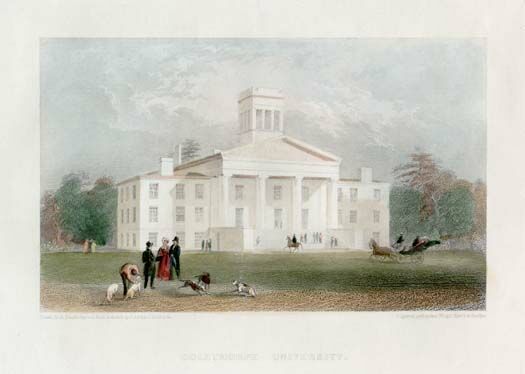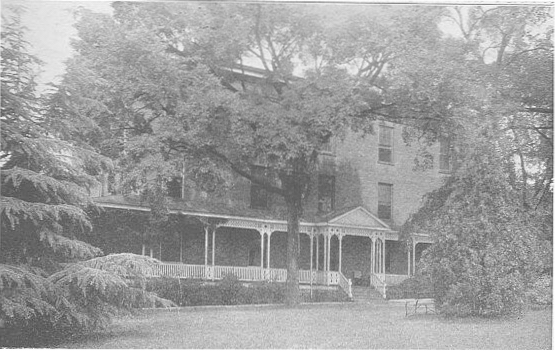
Painting by Thomas Addison
Richards
Oglethorpe University at
Midway
1836-1869

Painting by Thomas Addison
Richards
Oglethorpe University at
Midway
1836-1869
Oglethorpe University
opened its doors in 1838 with 125 students; the civil war forcing it to
close its doors in 1862. After briefly reopening after the war by 1869,
317 students had graduated. Dr. Henry Dawson Allen bought the land in 1890
and operated Allen's Invalid Home, a private hospital for the
treatment of nervous diseases. The summer of 1966, 104 years after
the school closed, I had the pleasure of working at Allen's
Invalid Home. My best friend and I shared a room on the second floor
of Thalian Hall. I remember the dark halls, high ceiling
rooms, beautiful marble top dressers and armoires for our clothing.
A single bathroom was at one end of the hall and the other
end was the poet Sidney Lanier's room. Looking through the
keyhole we saw the bed, desk and other items left there when he left
and joined the Confederate army. I had been interested in history
since a child, and it was a thrilling experience to work and live
there that summer. Below is some information I have gathered about the
university.
Robert Sears
in A pictorial description of the United States, embracing the history,
geographical position, agricultural and mineral resources ... etc., etc.
Interspersed with revolutionary and other interesting incidents connected
with the early settlement of the country wrote- "Situated
at Midway, in Baldwin County, on account of it's central position in a
pleasant and beautiful region, being a place easily accessible from all
directions. The spot is elevated, on a ridge lying east and west, two miles
and half south of Milledgeville, and ending at the bluff on Oconee river,
on which are the ruins of old Fort Wilkinson. The foundation of the edifice
is on a level with the top of the cupola of the statehouse; and the view
is extensive on every side, embracing an undulating surface of twenty miles
round, including Milledgeville.
The erection of the principal building was begun in 1836, and completed
in 1838. It is of brick, two stories high, with a basement, in the Doric
style; and being painted white, and of great extent, makes a striking appearance.
The chapel occupies the center, forty-eight feet by sixty, with a colonnade
and vestibule. The wings are each thirty feet in front, and three stories
high with professors' and recitation rooms while other rooms are appropriated
to the library, museum, apparatus, etc. Two ranges of small buildings stand
at some distance on each side, each containing two students rooms; while
the house of the president stands on the south side of the campus." (1). Later Thalian Hall (see photo), a three story brick building was
erected by the Thalian Society in 1859. It was designed by architect Joseph
Lane. Sidney Lanier's room was at the end of the hall on the second
story and was still there in 1966. The
building was demolished in the early 1990's.
Later Thalian Hall (see photo), a three story brick building was
erected by the Thalian Society in 1859. It was designed by architect Joseph
Lane. Sidney Lanier's room was at the end of the hall on the second
story and was still there in 1966. The
building was demolished in the early 1990's.
"The
institution commenced operations in January 1838 with six professors; and
the first class was graduated in 1839. It is under the direction of the
presbyterian synod of South Carolina and Georgia, but its advantages are
free to all. There are two sessions in the year: one from the fist Monday
in January to the second Wednesday in May; after which is a vacation of
four weeks. Commencement is held on the Monday succeeding the second Monday
in November."
Oglethorpe
University owes its origin to two manual labor schools, under the Education
Society of Georgia. That association was dissolved and in 1835 the
trustees of Midway seminary, which was one of those institutions offered
it to the Hopewell presbytery, who received it, and soon constituted a
college, under their government and control, with a charter from the legislature.
The charter forbids any shop to be open within a mile and a half of the
institution, on a penalty of five hundred dollars, or more, while deeds
of university lots provide for the forfeiture to it of lots on which such
shops may stand. This feature has since been introduced into other charters,
and has doubtless prevented many of the evils to which other literary institutions
are often liable."
Carlisle Pollock Beman
of New York was the first president of the college. After he resigned
in 1840 Rev. Samuel K. Talmadge of New Jersey was elected president and
served for 20 years.
The Macon Georgia
Telegraph of 11/40/1840 list the graduates of Bachelor of Arts
degrees on Nov. 11, 1840 to C. J. Williams, F. G. Davies, Bedney
F. McDonald, and W. G. Davies, of Milledgeville; C. S. Rockwell, Midway;
G. W. Hardwick of Columbia County, GA; R. W. Jemison, of Bibb County, GA;
John Bilbo, of Savannah.
The Macon Georgia
Telegraph of 11/29/1842 list the graduates of Bachelor of Arts
degrees on Nov. 13, 1842 to: Theodosius B. Davies, Francis T. Cullens,
T. Fort Bozeman, G. W. Fish and Charles W. Lane. Master of Fine Arts degree
to Thomas E. Loyd, Charles S. Rockwell and Charles J. Williams; honorary
degree of Master of Arts to Alexander A. Smetts of Savannah and Randolph
A. Ramsay of Midway.
In 1857 the university
library had 4000 books, mostly donations. ( Most
of these books were destroyed in a fire at the state house in 1894
which was being used as Georgia Military College.) It was
open twice a week, one hour each time and the books were lent within a
mile of the school at the discretion of the president. There
were two literary societies - Thalian and Phi Delta.
Some Professors: Judge Carleton
B. Cole, Rev. Samuel K. Talmadge, Rev. Thomas S. Witherspoon, Rev. Robert
C. Smith, Rev. J. M. Baker, Rev. Ferdinand Jacobs, Rev. C. W. Lane, Dr.
Joseph LeConte, Dr. James Woodrow, Prof. Nathan A. Pratt, Prof. Hunter,
R. H. Ramsey and Charles W. Howard.
Some Students:
James S. Bedds, Mathew E. Bingham, Tully Choice, James Cochran, Phillip
Cook, Robert W. Flournoy, William Frierson Fulton, Jr., Roger L. Gamble,
Fleming Grieve, John Grieve, Miller Grieve, Lemuel Kubler, Clifford Lanier,
Sidney Lanier, Thomas Langston, John LeConte, Joseph LeConte, John M. McMillan,
Eugenius Nesbit, Joseph Newell, Thomas F. Newell, Elisha Ramage, Robert
Ramage, Whitford Ramage, William J. Sasnett, D. D. James, Col. Robert A.
Smith, W. Smith, Oscar Thomas, Appleton Toney, William Toney, Andrew Weems,
Thomas H. Whitaker, and Robert Wiggins.
When the civil
war broke out students began to leave the university and volunteer for
Confederate service. 50 students formed "The University Guards" which was
the first local company. James C. Bonner in Milledgeville, Georgia's
Antebellum Capital, wrote "Governor Brown promised to arm them
from state arsenals, but he refused to disrupt their studies by ordering
them into service away from Milledgeville. Despite the governor's orders
to exempt Oglethorpe students from military duty, the exodus from the campus
continued. Many students such as Sidney Lanier, returned home and entered
volunteer units which carried no prohibitions against service outside the
state." (3) Students began to leave the university and volunteer for Confederate
service. "Oglethorpe's students suffered unusually high casualties.
According to the
Oglethope University web site, the University closed in 1862 due to the
Civil War when its students were soldiers, its endowment was lost in Confederate
bonds and its buildings were used for barracks and hospitals." James C.
Bonner in Milledgeville, Georgia's Antebellum Capital, wrote
" 11 unknown Confederate soldiers who died at this hospital are buried
at The
Old Midway Cemetery as well as some students. With the exception of
three students - Sidney and Clifford Lanier and Andrew Weems - the entire
chapter of the S.A. E. Fraternity was wiped out by the conflict."
According to Katherine Bowman Walters, in Oconee River, Tales to Tell
"
the carpets from Oglethorpe University were converted into blankets."
Classes resumed in 1866.
The capital moved to Atlanta and the university soon followed in 1870.
Anna M. Cook in The History of Milledgeville wrote , "The material
in the Main Building was sold to the State to be used in the construction
of the State Sanitarium. The steps of the T.O. Powell Building being the
same as those of these famous old institution of learning."
Dr. Henry Dawson
Allen bought the university property in 1890 and established Allen's
Invalid Home, a private hosptial for the treatment of nervous disease,
using the Talmadge home as his residence and Thalian Hall as a dormitory
for nurses. It was used for a treatment facility for veterans of World
War I.
Talmadge Avenue named after Samuel K.Talmadge
was changed to Allen Memorial Drive in honor of Dr. Henry Dawson Allen.
All traces of the university
are gone including Thalian Hall which was added to the National Register
of Historic Places in 1978. The spirit of the place and memories will linger
always with those connected to "Dr. Allen's".
Eileen Babb McAdams, Milledgeville, Ga.
Sources:
1. A pictorial description
of the United States, embracing the history, geographical position, agricultural
and mineral resources ... etc., etc. Interspersed with revolutionary and
other interesting incidents connected with the early settlement of the
country "..Sears, Robert, 1810-1892. Boston, J. A. Lee & Co., 1876.
2. History of Baldwin County
Georgia, Mrs. Anna Maria Green Cook
3. Milledgeville, Georgia's
Antebellum Capital, James C. Bonner
4. Oconee River, Tales
to Tell, Katherine Bowman Walters
5. 1850 Federal Census, Baldwin
County
6. One Hundred Three Lost
or Found Cemeteries of Baldwin County, Georgia 1814-1999, Compiled
by Elizabeth L. Dawson, Louise M. Horne, and Anne M. King.
7. Oglethorpe University web
site
More Information for the university
can be found in these books:
Allen, Sarah Cantey Whitaker,
Old
Oglethorpe University - Midway, Georgia
Tankersley, Allen P.,
College Life at Old Oglethorpe
copyright Eileen Babb McAdams 2002